Learning From COVID-19 to Look Ahead: How to Give Your Shoppers a Compelling Digital Experience


Learning From COVID-19 to Look Ahead: How to Give Your Shoppers a Compelling Digital Experience
Get The Print Version
Tired of scrolling? Download a PDF version for easier offline reading and sharing with coworkers.
A link to download the PDF will arrive in your inbox shortly.
In times of crisis — be it small or large — leaders have two responsibilities: to lead through it and to lead to it.
The most successful leaders are able to balance the in-crisis pivot based on needs in the moment, while at the same time working to set the business up for post-crisis success.
Harvard Business Review research looked at recession recovery to find that a careful balance between cost reduction and investment in growth was the best indicator of healthy recession survival.
What should that investment in the future look like for your business?
The short answer, according to Bloomreach’s Chief Strategy Officer Brian Walker is this:
“In short, emphasize digital and ecommerce. Consumers are of course gravitating online for both essentials and discretionary spend alike. And those digital shopping habits picked up today will become even more entrenched. Ecommerce and digital marketing performance will be critical not just to your online numbers, but your company’s overall results and earnings.”
Once stores begin to reopen, the chances of more intermittent social distancing orders — as well as the possibility that consumers may be wary of returning to crowded stores, at least at first — will make ecommerce a more necessary part of your business.
In this article, we’ll talk about why a compelling digital experience could be the investment you need to strengthen your market position post-pandemic. Then, you’ll find six steps to enhance your online presence and differentiate your brand in an increasingly competitive market.
COVID-19 Has Significantly Impacted Shopping Habits
By now, you’ve probably heard the big takeaways:
Shutdowns and stay-at-home orders have forced a great deal of commercial activity online.
The shakeup in our daily activities has shifted levels of demand across categories — some up, some down.
The significance of this crisis in our everyday lives will likely have a lasting impact on how, what, and why we buy.
Let’s dig into some of the data.
This graph provided by Bloomreach shows some trends emerging as people respond to this widely shared experience.
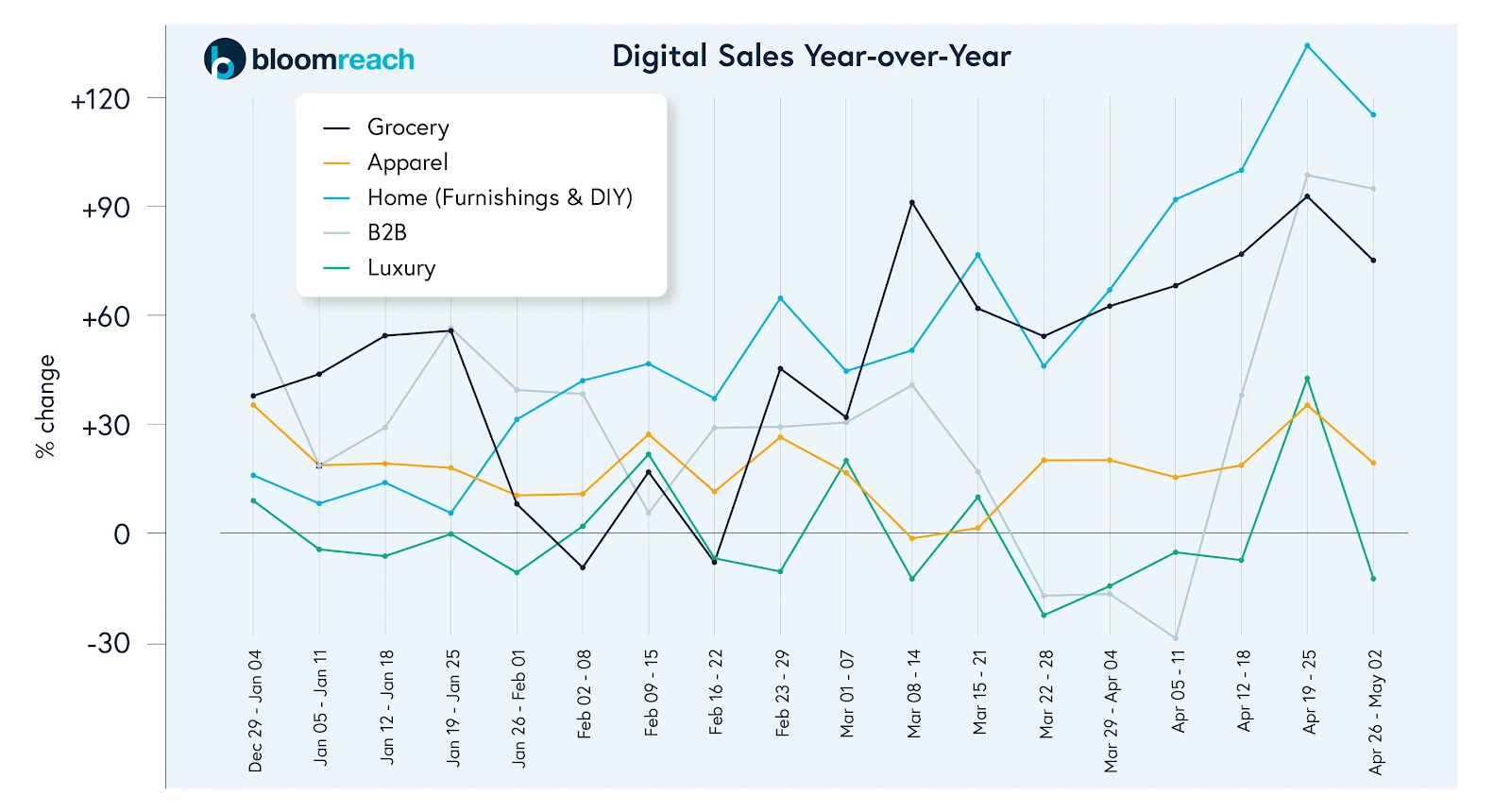
1. Grocery makes a significant entry into ecommerce.
In the early weeks of the pandemic, utilitarian motivations took center stage and necessities like toilet paper flew off the shelves as consumers attempted to find some semblance of control in an unprecedented situation.
While Grocery wasn’t previously a significant player in the ecommerce space, you can see in the graph above that sales in the vertical jumped up in late February. It peaked the second week of March, right around the time shelter-in-place directives began. At the same time, there was a significant drop in Apparel and a downswing for Luxury as well.
2. Discretionary spending slowly returns, with a focus on the home.
As time progressed, however, anxieties settled somewhat into a new routine, sparking a slow bounce-back of discretionary spending. And, based on the steady rise of Home Furnishings & DIY starting in early April, consumers’ big priority was items to make their daily lives at home more comfortable and enjoyable. A few weeks later, you can see Apparel and Luxury beginning to rebound as well.
3. B2B businesses struggle to balance supply and demand.
The data show an initial spike in B2B sales — then a big dip, as suppliers struggled to keep up with demand, and distributors experienced shortages and out-of-stock items.
4. Shopping is moving online.
Online traffic has a much more straightforward story to tell than online sales. “Every segment has seen year-over-year increases in overall traffic,” said Walker. “Consumers are adapting to the situation and going digital.”
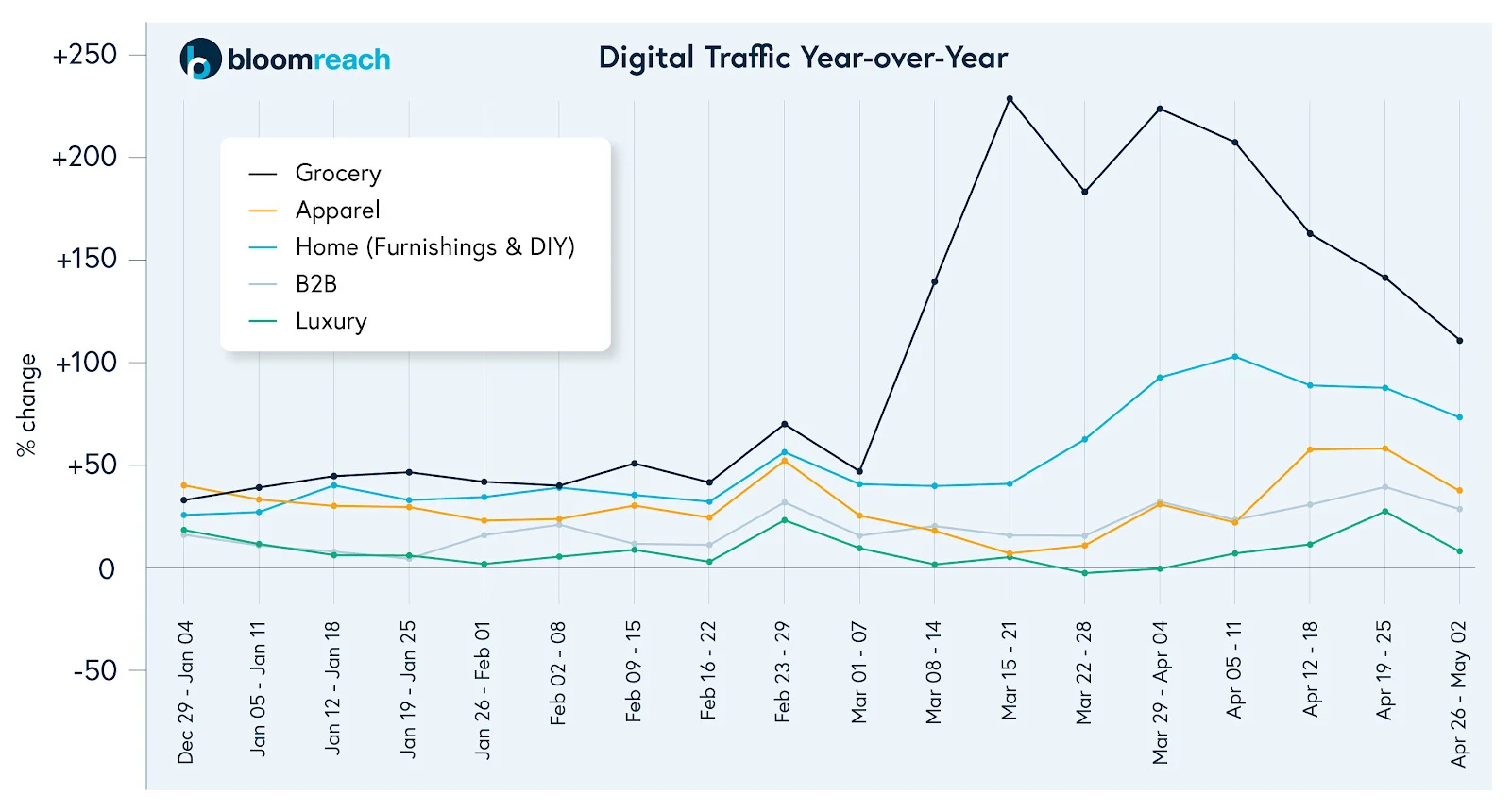
Books could be written (and probably will be) about all the impact of coronavirus on commerce and consumption activities, but for the purposes of this article, we’ll focus on that first big takeaway mentioned above: the shift toward ecommerce.
Commerce After COVID-19
The remaining unknowns haven’t stopped people from making some educated predictions about what commerce will look like after COVID-19 makes a significant retreat.
The Economist predicts that the pandemic and our responses to it will “accelerate … an energising adoption of new technologies,” and businesses are escalating their digital transformation efforts.
It’s clear that, even as we phase back into normal life, we’re going to be turning to digital over in-person activity when possible for a relatively significant amount of time to come. For brands who are more focused on brick-and-mortar, this presents a big opportunity to dive into expanding their digital presence and evolving alongside consumer behavior in this unprecedented time.
Ecommerce’s share of retail sales was already growing — but the pandemic will almost certainly accelerate that growth into the coming years.
“Digitally mature organizations have a huge advantage and are better able to weather this storm,” says Walker, based on insights from Bloomreach’s data. “What’s happening now will have long-term implications on shopping behavior post-COVID.”
Customer Experience is a Differentiator
More people shopping online brings more potential demand, but it also brings more competition. Brands who’ve already been focused on ecommerce may see some new merchants pop up on their competitive radar.
As we move further toward a digital-first world, brands will have to work harder to give customers a rich, compelling shopping experience that holds their attention and keeps them coming back for more.
The good news is that giving the customer the experience they want will help you, too.
Walker suggests that brands be ready to “differentiate themselves with compelling digital experiences, as well as ones that link together channels for fulfillment, such as curbside or in-store pick-up.”
He continues: “Amazon and other large aggregators will be looking to take a larger share of the ecommerce pie. Start considering how to go beyond the table stakes of digital commerce to differentiate with curated, highly personalized experiences that connect emotionally with customers. Just don’t forget the table stakes of clear communication, great search, and frictionless checkout.”
The more experiential elements you include on your digital properties, the more you’ll engage your shoppers. That engagement with your brand will positively impact brand perception and help them better understand your products and services. It can also have more tangible benefits, like increasing conversion rates and customer loyalty.
Steps to Creating the Best Digital Experience for Your Brand
“Experience” is one of those words that can mean so many things, that it starts to feel vague and wishy-washy. So let’s look at what “experience” really means in the context of ecommerce.
An experience is ongoing as opposed to a one-off activity and encompasses much more than just a conversion. A holistic experience will include multiple sensory inputs or other ways to draw the user into participation with the brand — the focus is on the journey rather than just the final transaction.
There are almost limitless possibilities to enrich the digital experience for your consumers. Admittedly, that can be overwhelming — and you have to walk before you can run. Here are the steps we suggest to begin creating the experience you’ve envisioned.
1. Assess the current state of your website.
Before you start to redecorate, you should take care of needed repairs and decluttering. Make sure all your technology is updated and still providing value — or get rid of it before it becomes a security concern.
Then you can start to think about how to improve your digital property to create a rich and compelling shopping experience.
Competitor analysis
Look closely at your competitors’ stores. How do they bring their brand experience to life? How are they positioning their products? What tools and tactics are they using to increase conversions and retention rates? You don’t want to copy your competitors, but do you need to be offering a comparable experience in both form and function.
Mobile readiness
Mobile ecommerce traffic continues to rise, and the prevalence of payment options are making it easier than ever to complete the buyer’s journey on a smartphone. Take the time to dig into the purchase experience on mobile and identify any friction points you can eliminate.
Site speed
Some of you might remember the early days of streaming media and that dreaded word: “buffering.” Slow page load speeds on your website will frustrate a user right out the digital door — and they have a negative impact on your SEO as well.
2. Optimize for conversions.
As long as your site has been up and running long enough to have a viable amount of traffic, you can perform a conversion rate optimization audit. A CRO audit will help you drill down into the moments that make or break the conversions across your ecommerce site.
Look at your web analytics for the last six months to a year. Are there any learnings you can take from the data along the user journey — like abandoned carts or bounce rate — that you can use to improve the customer experience?
Calls to action
In just two to four words, a CTA must incite user action with a clear message about what’s in it for them — that aligns with their personal motivations for shopping. Use action verbs and emphasize value to communicate what to do and why.
Design also plays an important role in CTAs. Make sure the button size is proportional to the rest of the text, and leave some white space around the border. You want it to stand out.
Now, you can further optimize your CTAs through A/B testing. For example, if you have rectangular CTAs, you might want to test against a version with rounded edges. Or you can compare performance between “Buy Now!” vs. “Get Yours Today!” Just make sure you only test one change at a time so you know how each change impacts performance.
Product category structure
The way your products are categorized and presented in the main navigation on your homepage will have a lot of impact on your users’ perceptions, experience, and ability to find what they want and need. For best usability, you want to keep categories specific enough that they have meaning, but without “over-categorization.”
Testimonials
Featuring testimonials can be an important factor in your conversions, because shoppers have shown proven positive response to social proof. 79% of people say that user generated content, which demonstrates social proof by showcasing real customers’ experiences, highly impacts their purchasing decisions. And that makes sense. Ecommerce’s biggest challenge is selling a tactile product to someone sight unseen. Testimonials and product reviews serve as a way to provide proof that the product is and does what it claims.
The checkout process
The challenge with the checkout process is that it has to walk a tightrope between gaining enough information from the user to complete the transaction, and not asking for so much that the user gets frustrated and abandons their cart. 21% of U.S. online shoppers have reported abandoning a cart because of a too long or complicated checkout process.
3. Build out an SEO strategy.
SEO isn’t a task, it’s a process. And it’s never too late to start. Even if you have strong SEO performance, there’s always room to optimize this valuable area.
While SEO may seem at first like an unlikely way to improve shoppers’ digital experience, it actually plays a large role in things like your site speed, your customers’ ability to find your website, their ability to quickly find the products they need — either through search or relevant categorization.
Technical SEO
Technical SEO is the process of making sure your site is optimized for crawling and indexing. It can be a bit complex and you may want to consult with an experienced professional — but why not now? It’s important to the findability, functionality, and usability of your site.
On-page SEO
On-page SEO refers to optimizing individual pages on your website to increase their ranking on search engine results pages (SERPs). This can be front-end optimization or within the HTML code. It differs from off-page SEO, in that off-page refers to off-page signals like links.
Local SEO
If you have a brick-and-mortar or sell products specific to a certain geographic region, you’ll want to optimize your SEO for local search. This will help people who are looking for things “near me” to find you.
As you’ve probably seen in your own Google searches, when you conduct a local online search, you get two types of results. The group of results on top are called the Google Snack Pack.
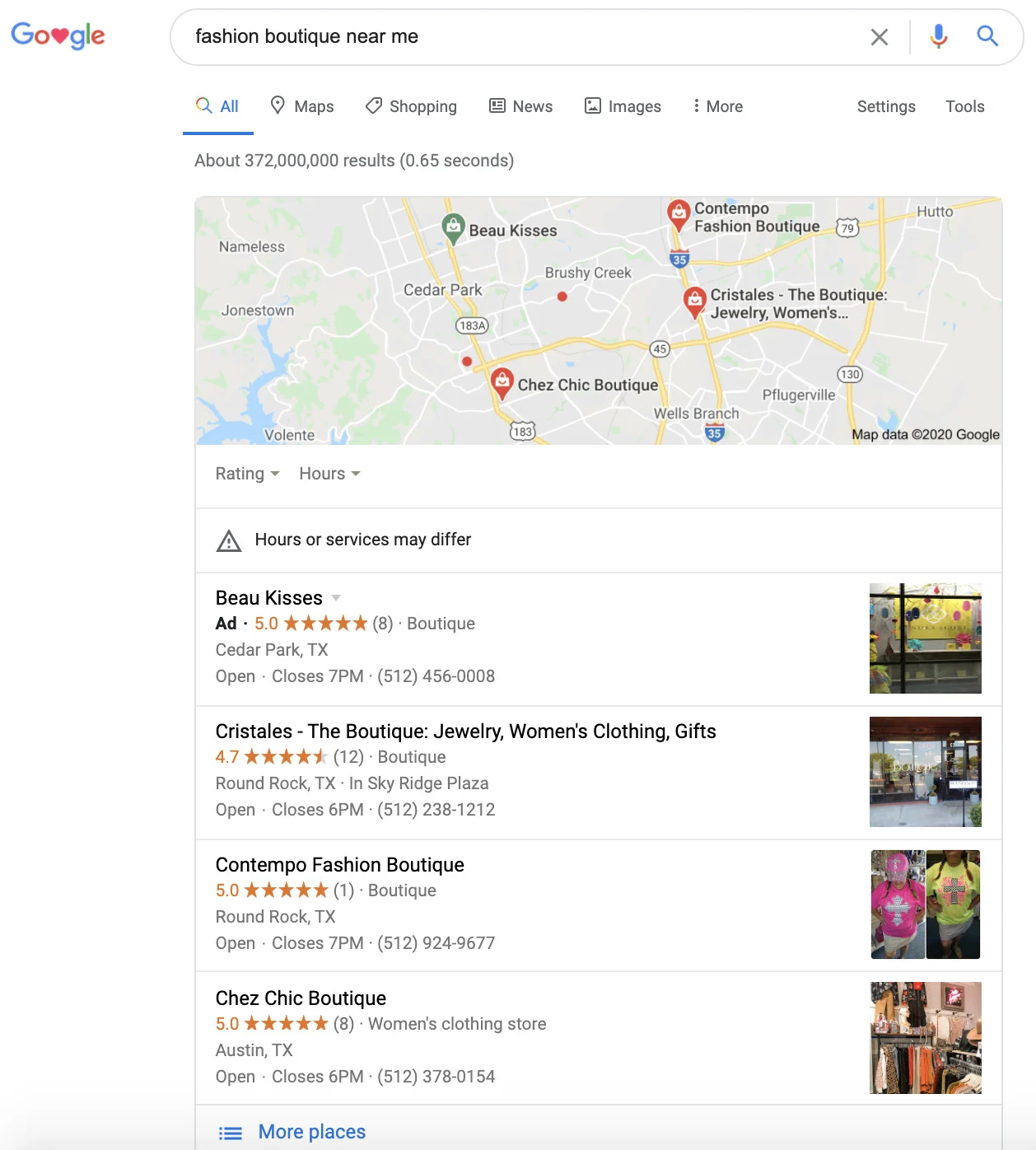
First, claim and optimize your Google My Business listing, as Google will use that information to populate responses to local searches. You’ll also want to make sure that your site looks good and works well on mobile devices, as just-in-time searches for physical locations are often conducted on the go.
Establish backlink strategy
Backlinks are links on other websites that lead back to yours. Here are a couple of hypothetical examples:
You contribute an article to a media site and link to your company’s homepage in your author bio.
A blogger mentions your product or service on their website with a link to the product page on your website.
Backlinks work to legitimize your site, helping Google understand that it’s valuable content. That’s what gives it what’s called “domain authority.”
But not all backlinks are created equal. The ones that will mean the most to your ranking are backlinks coming from other reputable, trusted sites — those with high domain authority.
One more caveat: make sure your backlinks are relevant. Google will put less weight on backlinks to your home-and-garden shop from, say, a skateboard shop than they would an interior decorating magazine.
4. Create a variety of content.
The main goal of content marketing is to provide value-add content without — or with only a touch of — a sales pitch in order to build authority, community, and trust.
Content is a great way to engage your customers while they’re on your site, keeping them on-site longer and increasing the likelihood of their return. Varying your content types — text, visual, multimedia — will keep it fresh and interesting, and make the experience on your ecommerce site more dynamic and interactive.
Blogs
You can use your content to improve shoppers’ digital experience by providing an engaging way to learn about your brand and products. Use that SEO strategy we just talked about to develop a content plan.
Some of the functions of blog content include entertaining your shoppers and/or answering their questions about your product (e.g., “What is CBD, anyway?”), your policies, or who you are as a brand.
Videos
Videos can communicate your brand story or highlight your products in a more engaging way by making customers feel like active participants. By using story to influence emotion and spark engagement, narrative-driven videos can elicit deeper brand affinity in your customers.
Product-driven videos, on the other hand, provide a more immersive way to learn about products through movement (obviously) and context.
User-generated content
Content created by your customers can take you a long way. It’s more authentic, it provides social proof, and it builds a community affinity. All this leads to growing shoppers’ purchase intent. You can use UGC to build brand awareness and create demand and showcase brand loyalty — which in turn inspires others to share theirs as well. This is solidifying a relationship between you and your most loyal customers.
Augmenting your website with some user-generated content can also nudge shoppers into conversion, because experiencing digital content from real people who also like the product can be reassuring.
5. Integrate social media.
In Disney’s The Little Mermaid, Ariel — before getting legs and walking ashore — sang, “I want to be where the people are.” So do we marketers, Ariel. And the people are on social media.
Having a presence on the right social media platforms can give you the opportunity to deliver a strategic multi-channel experience. You’ll want the experience to be integrated, with the same messaging, community feeling, and branding.
Augmenting your social media with Messenger Chat to answer shopper questions on-platform is recommended as is engaging with your customers as much as possible to reinforce the brand.
Some platforms are even making in-app purchases possible, through Facebook Messenger, Facebook Marketplace, or Checkout on Instagram. Learn more about each, and the demographic they serve, before you dive into something that might not be right for your business.
Here’s an example, using Anchor & Crew’s Facebook page:
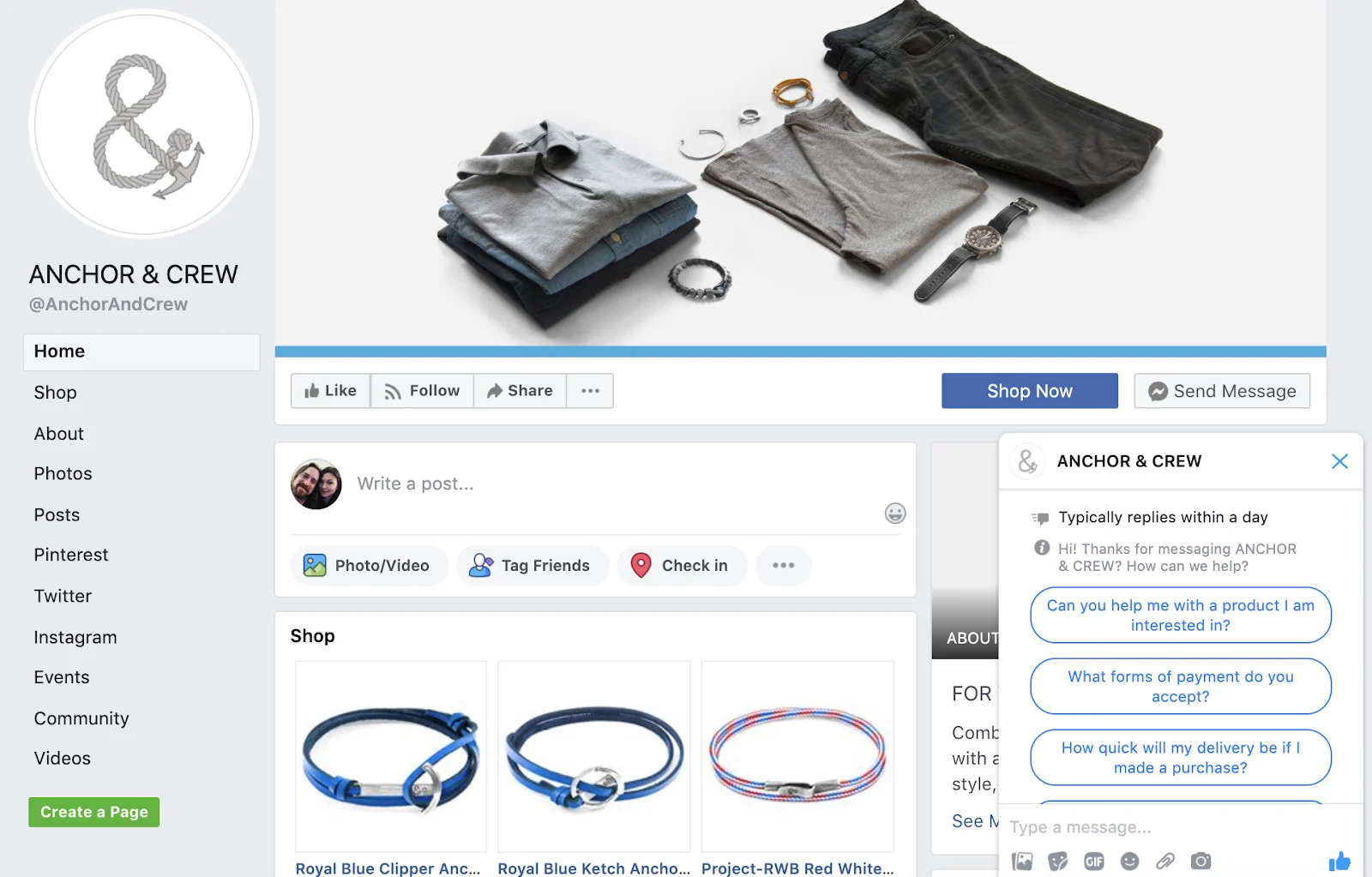
You can see they have Facebook Messaging to help customers find the answers to their questions, and they also provide the opportunity to shop directly on the page. The images and color palette used keep the brand consistent with its website.
6. Personalize, personalize, personalize.
Customers want a personalized experience — and it can also make them more likely to come back. Use personalization to make customers feel a unique level of service typically not otherwise available on an ecommerce website.
Skincare line Bliss is a great example of creating personalized customer touchpoints. One way they both make the on-site experience feel more personal and answer customer questions in a useful and engaging way is through a quiz on their homepage.
This interactive quiz helps shoppers understand their unique skin types and points them in the right direction for the best products for them.
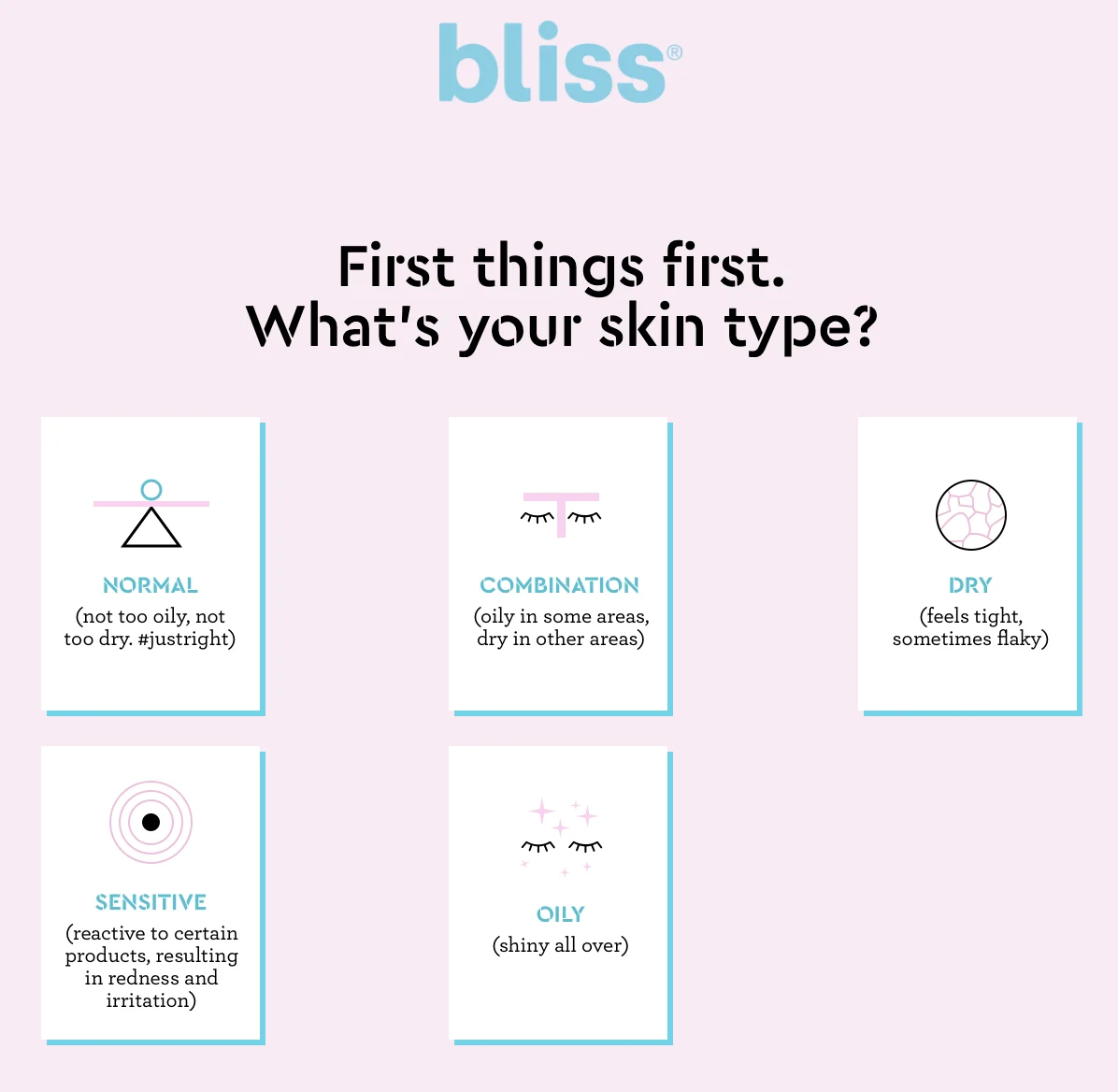
Ecommerce product pages
Personalizing ecommerce pages can help assist with up-selling. Some ecommerce websites personalize product pages by showing additional recommendations based on products you’ve viewed or purchased before. Others offer recommendations for products that are complementary to the one featured on the page.
Bliss does the latter, showing this selection of related products on a product page:
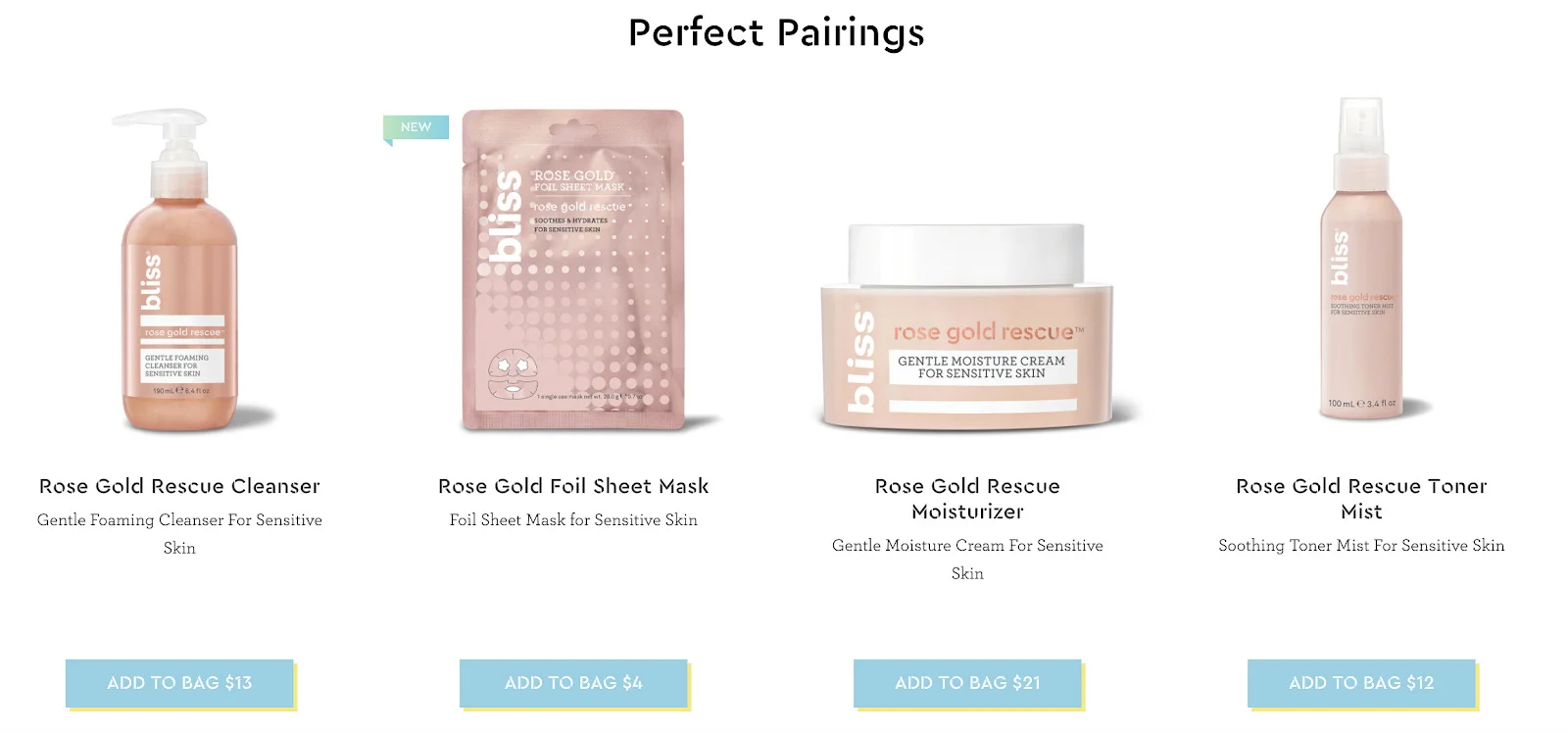
Email marketing
Personalization in email marketing can refer to a lot of different things. On the ground level, it’s including your customer’s actual name in the greeting and/or subject line, rather than relying on a “Hey, you!” You could also experiment with customer segmentation to optimize getting the right offers to the right people.
And you can also trigger emails to shoppers based on their interactions with the site. Here’s the email Bliss sent an hour or so after I viewed products on their site:
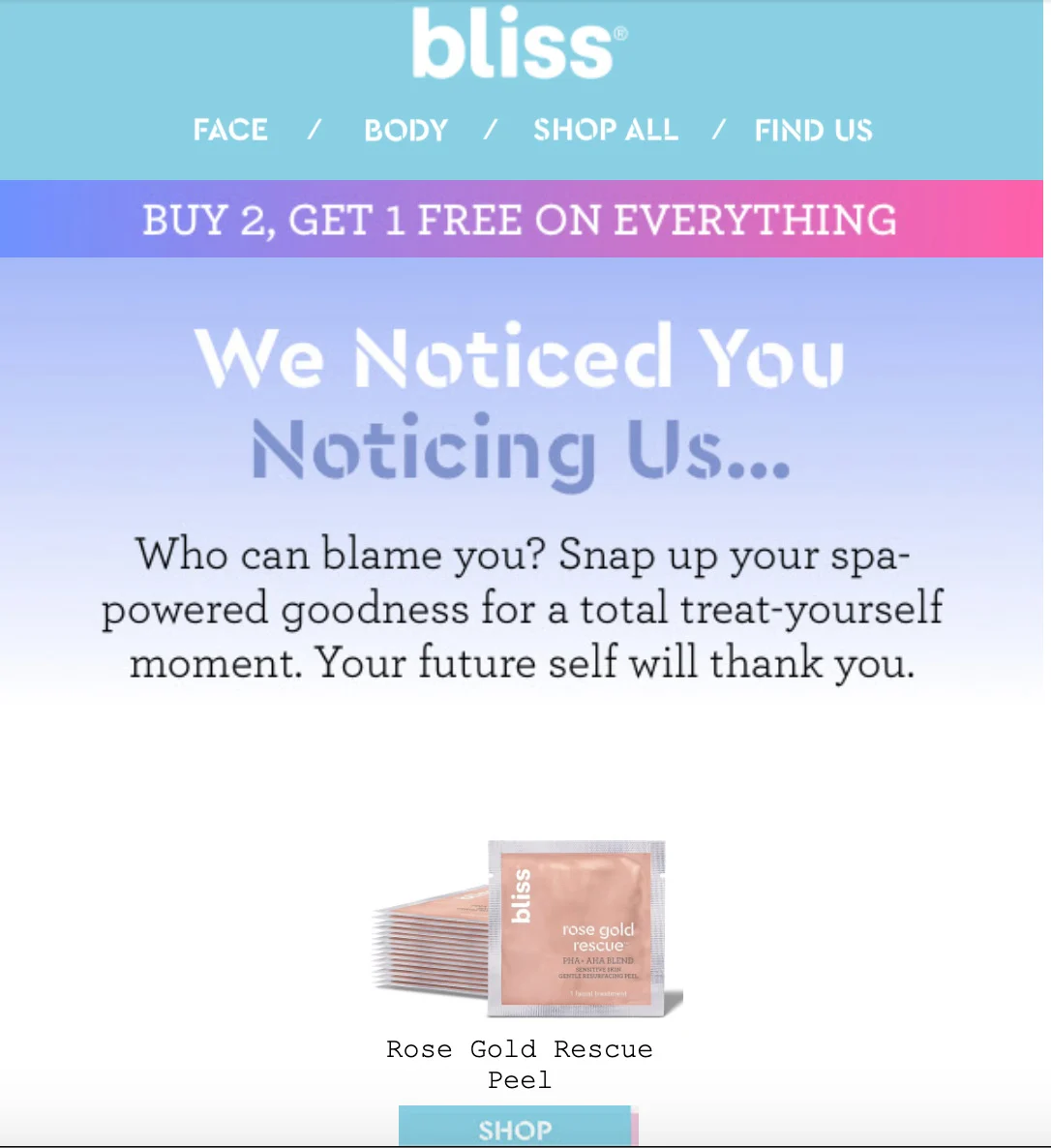
Paid ads
Ads might not seem like the most obvious place to personalize, but there are really some interesting things you can do with them. Have you ever landed on a site that looked like it was talking directly to you? (Or, at least, your company… ) This showed up for me a couple of weeks ago as I was catching up on the news.

Retargeting is another way to target your shoppers, especially if they abandoned a transaction. The day after viewing the Bliss products above, I was catching up on the news (again) and this ad appeared:
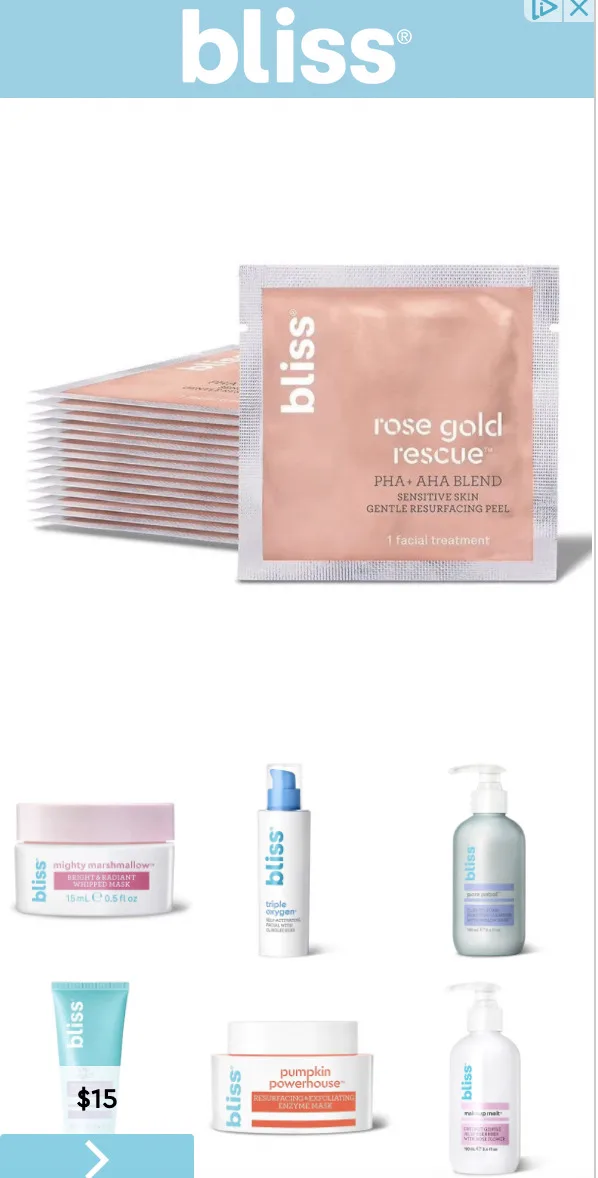
This ad was built in HTML5 (it’s not just an image) — and that means it can be animated and interactive. That means the shopper is seeing a number of different products in addition to the one that had the most time spent on page.
For some, this will be just the right amount of targeting — a reminder of what you were looking at, and what else is available, without stalking them across the web with just one product.
Keep Your Customers Front and Center
As you set out to improve your customers’ digital experience, remember the most important maxim: “Just because you can doesn’t mean you should.”
Evaluate every opportunity with your customers in mind. Is this something that will enhance their lives? Think of who your audience is, what they need to know, and what they want.
Use Twitter as an example. Your particular business might do well on Twitter, but if you’re an apparel company, Instagram is probably a better option.
1. Remain true to your brand’s identity.
It’s not uncommon for people to get distracted by new and shiny objects. But it’s important that no matter what you pursue, it should align with your brand identity. Think of your mission, vision, values, brand personality, positioning, and voice. If your digital experience doesn’t align with your identity, consumers at worst will be confused; at best, you’re probably not deepening their connection.
2. Focus on what resonates.
Those shiny objects again — if they don’t resonate with your consumers, you’re wasting time and money. Focus your efforts where they have the most value for your consumers. If what they really want is streamlined checkout but you’re adding videos to product pages, they’re still going to be frustrated throughout the purchase process.
3. Ask for feedback.
Experiences are interactive. You can tell a lot from analytics around those interactions on your site and on social media platforms, but don’t neglect the opportunity to get qualitative feedback as well. As customers what they think. Run surveys and get a sense of what they love about your brand, if your site experience improves their brand loyalty, and if there’s any friction you need to address.
Conclusion
More consumers are shopping online than ever right now. How much of that spending will stay online even after stores re-open remains to be seen, but the return to brick-and-mortars may still be slow due to fear of future outbreaks.
Building a compelling digital experience now means you’ll be ready whether in-store shopping comes back, or consumers’ preference for ecommerce increases even more. Giving shoppers an experience can differentiate you from the highly competitive ecommerce market and create community loyalty.
While it may seem daunting at first to go about creating a highly personalized digital experience on your ecommerce site, it doesn’t have to happen overnight. As you make incremental improvements, keep a close watch on your analytics to see what’s working and what isn’t, and adjust accordingly. Getting to a great digital experience is a journey; follow the steps in this article to start yours with confidence.

Victoria is a content marketing writer, researcher, and content project manager at BigCommerce. Specializing in writing and web content strategy, she previously spent eight years in public relations and marketing for Tier I research universities. She holds a B.A. in English Writing and Rhetoric from St. Edward’s University and a Master of Liberal Arts from Lock Haven University of Pennsylvania.


